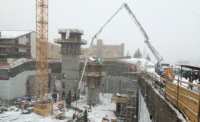Hogle Zoos New Rocky Shores Exhibit Brings the Bears Back to Town










All that piping connects the nearly 400,000 gallons of water in separate exhibit tanks to an extensive pumping, treatment and filtering system designed by a specialty engineering team from the San Diego office of MWH Americas Inc.
MWH engineer Joe Arlotto has designed aquariums and zoo exhibits for 20 years and says there is a considerable amount of complexity to the Rocky Shores system. Each of its habitats has separate filters as well as systems to inject disinfecting ozone, protein and bubble-removing substances to ensure the clearest water for viewing. Two of the habitats, those for the seals and polar bears, use saltwater, which adds complexity to the system.
"We designed this system to be able to backwash the filters when they have too much buildup," Arlotto says. "We can send water through and remove particles and salt. This conserves the salt we have and reduces the amount we discharge into the sewer system."
Arlotto adds that pipes returning water to the tanks were positioned so the zoo staff can create currents to move debris to areas where it can be easily removed, either by pool filters or by staff above the tanks using a vacuum system.
Zookeepers can also warm or cool the water depending on the season and the needs of individual animals. A 300-ton chiller provides cooling for air conditioning the indoor public spaces as well as for the water in the animal habitats, Lund says.
Arlotto adds that the system is controlled from a central monitoring station that can be accessed remotely and sends alerts to zoo staff when there is a problem.
According to Stefansson, the exhibit was designed to provide visitors a chance to observe animals from a variety of locations and settings. It utilizes 3,867 sq ft of glazing, ranging in thickness from 2 to 3 in.
Lund notes that while much of the glazing is designed for observing the animals underwater, some portions are one-way glass so the animals can be observed without them seeing the public. Stefansson says a demonstration area has glass panels that open to allow people to watch caretakers working with the animals.
Behind the public face of the exhibit is a collection of holding pens where the bears can be housed separately. Lund says the pens are needed so that the zoo can undertake a breeding program in the future.
PROJECT TEAM
Owner: Utah’s Hogle Zoo
Architect: CLR Design
General Contractor: Sirq Construction







